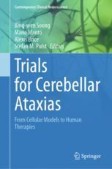Search
Search Results
-
Single-Session Cerebellar Transcranial Direct Current Stimulation Improves Postural Stability and Reduces Ataxia Symptoms in Spinocerebellar Ataxia
Spinocerebellar ataxia (SCA) results in balance and coordination impairment, and current treatments have limited efficacy. Recent evidence suggests...

-
A Chinese Family with Digenic TBP/STUB1 Spinocerebellar Ataxia
Spinocerebellar ataxias (SCAs) are inherited neurodegenerative diseases characterized by loss of balance, coordination, and slurred speech. Recently,...

-
The Phenotypic Spectrum of Spinocerebellar Ataxia Type 19 in a Series of Latin American Patients
Spinocerebellar ataxia 19 (SCA19) represents a rare autosomal dominant genetic disorder resulting in progressive ataxia and cerebellar atrophy. SCA19...

-
Content Validity of the Modified Functional Scale for the Assessment and Rating of Ataxia (f-SARA) Instrument in Spinocerebellar Ataxia
The functional Scale for the Assessment and Rating of Ataxia (f-SARA) assesses Gait, Stance, Sitting, and Speech. It was developed as a potentially...

-
Development and Validation of SCACOMS, a Composite Scale for Assessing Disease Progression and Treatment Effects in Spinocerebellar Ataxia
Spinocerebellar ataxias (SCA) are rare inherited neurodegenerative disorders characterized by a progressive impairment of gait, balance, limb...

-
Potential Clinical Benefit of Very Long Chain Fatty Acid Supplementation in Spinocerebellar Ataxia Type 34
Spinocerebellar ataxia type 34 (SCA34) is a dominantly inherited disease that causes late-onset ataxia, in association with skin lesions in the form...
-
Psychometric Validation of the Modified Functional Scale for the Assessment and Rating of Ataxia (f-SARA) in Patients With Spinocerebellar Ataxia
This study aimed to generate evidence to support psychometric validity of the modified functional Scale for the Assessment and Rating of Ataxia...

-
Patient-Reported Outcome Measure of Ataxia Correlates with Canonical Clinical Assessments in Chinese Spinocerebellar Ataxias
Spinocerebellar ataxia (SCA) patients’ reports of their own experiences are essential to the outcome evaluation in clinical trials. To better...

-
Severe Neurodevelopmental Disorder in Autosomal Recessive Spinocerebellar Ataxia 13 (SCAR13) Caused by Two Novel Frameshift Variants in GRM1
Autosomal recessive spinocerebellar ataxia 13 (SCAR13) is a neurological disease characterized by psychomotor delay, mild to profound intellectual...
-
Factors Influencing Health-Related Quality of Life of Patients with Spinocerebellar Ataxia
BackgroundLittle is known about the progression of health-related quality of life (HRQoL) and predicting factors in spinocerebellar ataxia (SCA)....

-
A Case of Coexistent Spinocerebellar Ataxia Type 2 and Primary Progressive Multiple Sclerosis—Coincidental or Associated?
Spinocerebellar ataxia type 2 (SCA2) is a dominantly inherited ataxia primarily characterised by progressive cerebellar syndrome, which is developed...

-
Novel CWF19L1 mutations in patients with spinocerebellar ataxia, autosomal recessive 17
Spinocerebellar ataxia, autosomal recessive-17 (SCAR17) is a rare hereditary ataxia characterized by ataxic gait, cerebellar signs and occasionally...

-
A Cysteinyl-tRNA Synthetase Mutation Causes Novel Autosomal-Dominant Inheritance of a Parkinsonism/Spinocerebellar-Ataxia Complex
This study aimed to identify possible pathogenic genes in a 90-member family with a rare combination of multiple neurodegenerative disease...

-
CAT Interruption as a Protective Factor in Chinese Patients with Spinocerebellar Ataxia Type 1
Spinocerebellar ataxia type 1 (SCA1) is the third most common type of spinocerebellar ataxias in China. CAT interruptions in the pathogenic alleles...

-
Spinocerebellar ataxia type 31 (SCA31)
Spinocerebellar ataxia type 31 (SCA31) is one of the most common forms of autosomal-dominant cerebellar ataxia in Japan. SCA31 has a strong founder...

-
A Novel TTBK2 Mutation in a Chinese Pedigree with Spinocerebellar Ataxia 11
Spinocerebellar ataxia type 11 (SCA11) is a rare disease and the tau tubulin kinase 2 ( TTBK2 ) gene was the causative gene. To date, only six SCA11...

-
Serum S100β Levels Are Linked with Cognitive Decline and Peripheral Inflammation in Spinocerebellar Ataxia Type 2
Experimental and clinical studies have indicated a potential role of the protein S100β in the pathogenesis and phenotype of neurodegenerative...

-
Spinocerebellar Ataxia Type 7: From Mechanistic Pathways to Therapeutic Opportunities
Spinocerebellar ataxiaSpinocerebellar ataxia (SCA) type 7 (SCA7) is a cerebellar and retinal neurodegenerative diseaseNeurodegenerative diseases...
-
Two New Families and a Literature Review of ELOVL4-Associated Spinocerebellar Ataxia Type 34
Autosomal dominant variants in ELOVL4 cause spinocerebellar ataxia type 34 (SCA34; ATX- ELOVL4 ), classically associated with a skin condition known as...

-
Therapy Development for Spinocerebellar Ataxia: Rating Scales and Biomarkers
Spinocerebellar ataxias (SCAs) are a group of dominantly inherited disorders with progressive cerebellar dysfunction. Although there are no Food and...
